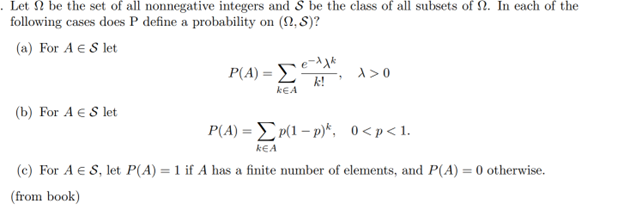Let be the set of all nonnegative integers and S be the class of all subsets of . In each of the following cases does P define a probability on (22, S)? (a) For A € S let (b) For A € S let P(A) = Σ KEA е-лак k! 1 X>0 P(A) = Σ p(1 - p)*, 0
Let be the set of all nonnegative integers and S be the class of all subsets of . In each of the following cases does P define a probability on (22, S)? (a) For A € S let (b) For A € S let P(A) = Σ KEA е-лак k! 1 X>0 P(A) = Σ p(1 - p)*, 0
Elements Of Modern Algebra
8th Edition
ISBN:9781285463230
Author:Gilbert, Linda, Jimmie
Publisher:Gilbert, Linda, Jimmie
Chapter1: Fundamentals
Section1.5: Permutations And Inverses
Problem 3E
Related questions
Question

Transcribed Image Text:Let be the set of all nonnegative integers and S be the class of all subsets of . In each of the
following cases does P define a probability on (22, S)?
(a) For A € S let
(b) For A € S let
P(A) = Σ
KEA
е-лак
k!
1
X>0
P(A) = Σ p(1 - p)*, 0<p<1
k€A
(c) For A € S, let P(A) = 1 if A has a finite number of elements, and P(A) = 0 otherwise.
(from book)
Expert Solution
This question has been solved!
Explore an expertly crafted, step-by-step solution for a thorough understanding of key concepts.
Step by step
Solved in 3 steps with 3 images

Recommended textbooks for you

Elements Of Modern Algebra
Algebra
ISBN:
9781285463230
Author:
Gilbert, Linda, Jimmie
Publisher:
Cengage Learning,

Linear Algebra: A Modern Introduction
Algebra
ISBN:
9781285463247
Author:
David Poole
Publisher:
Cengage Learning

Elements Of Modern Algebra
Algebra
ISBN:
9781285463230
Author:
Gilbert, Linda, Jimmie
Publisher:
Cengage Learning,

Linear Algebra: A Modern Introduction
Algebra
ISBN:
9781285463247
Author:
David Poole
Publisher:
Cengage Learning